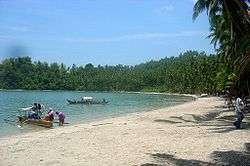Samar
Samar (/ˈsɑːmɑːr/ SAH-mar) is the third largest island in the Philippines. Located in eastern Visayas, within central Philippines. The island is divided into three provinces: Samar (the western two-fifths of the island of Samar), Northern Samar, and Eastern Samar. These three provinces, along with the provinces on the nearby islands of Leyte and Biliran are part of the Eastern Visayas region.
 Panapukan Beach on Samar | |
 Location within the Philippines | |
| Geography | |
|---|---|
| Coordinates | 12°00′N 125°00′E |
| Archipelago | Visayas |
| Adjacent bodies of water | |
| Area | 13,428.8 km2 (5,184.9 sq mi)[1] |
| Area rank | 63rd |
| Coastline | 800.6 km (497.47 mi)[2] |
| Highest elevation | 850 m (2,790 ft) |
| Highest point | Mount Huraw |
| Administration | |
| Region | Eastern Visayas |
| Provinces | |
| Largest settlement | Calbayog (pop. 183,851) |
| Demographics | |
| Population | 1,751,267 (2010)[3] |
| Pop. density | 130.4/km2 (337.7/sq mi) |
Samar is the eastern-most island in the Visayas. About a third of the island is protected as a natural park known as the Samar Island Natural Park. The island is separated from Leyte by the San Juanico Strait, which at its narrowest point is only about 2 kilometres (1.2 mi) across. This strait is crossed by the San Juanico Bridge. Samar lies southeast of the Bicol Peninsula on Luzon, the country's largest island; the San Bernardino Strait separates the two. To the south of Samar is the Leyte Gulf, which was the site of the Battle of Leyte Gulf, one of the most decisive naval battles during the Second World War. The gulf opens out into the Philippine Sea, found to the east of Samar and is part of the Pacific Ocean.
On June 19, 1965, through Republic Act No. 4221, Samar was divided into three provinces: Northern Samar, Western Samar and Eastern Samar with Catarman, Catbalogan City and Borongan City as its capital, respectively.[4] Thus, June 19 is a regular non-working local holiday of the said provinces.
History
Spanish Contact
Samar was the first island of the Philippines sighted by the Spanish expedition of Ferdinand Magellan on 16 March 1521 after having left the Mariana Islands. Realizing he had arrived at an archipelago he charted the islands as San Lazaro (Saint Lazarus in English) because they were sighted on Lazarus Saturday. The Spaniards eventually called the island Filipinas, but the Portuguese called it Lequios. Even if Samar was the first island of the Philippines sighted by Magellan, he did not land and continued sailing south till, after anchoring at Suluan Island, he finally landed on Homonhon Island on 17 March 1521.[5]
Other Spanish expeditions arrived years later. Historian William Henry Scott wrote that a “Samar datu by the name of Iberein was rowed out to a Spanish vessel anchored in his harbor in 1543 by oarsmen collared in gold; while wearing on his own person earrings and chains.” In the local epic called siday entitled "Bingi of Lawan" as written in the article of Scott, Lawan is a prosperous Lakanate in Samar. Datu Hadi Iberein came from the Lakanate of Lawan [6]
Philippine-American War
The final campaign of the Philippine–American War (1899-1902) took place in Samar and is one of the best known, and most notorious, of the entire war. A combination of factors resulted in particularly violent clashes.
Balangiga Encounter
On September 28, 1901, Eugenio Daza, Area Commander of Southeastern Samar and Valeriano Abanador, the town's police chief, launched an attack on U.S. Army Company C 9th Infantry Regiment who were occupying Balangiga. The Filipino Forces brought one of the only Filipino victories of the war and the worst American defeat in decades.
In 1989, "Balangiga Encounter Day" was established as a provincial holiday in Eastern Samar to celebrate the Balangiga Encounter victory.[7][8]
March across Samar
The Balangiga Encounter resulted in the brutal March across Samar.
"I want no prisoners. I wish you to kill and burn; the more you kill and burn, the better it will please me ... The interior of Samar must be made a howling wilderness ..." — Gen. Jacob H. Smith
Thousands of Filipinos were slaughtered by American Marines.
In his history of the war,[9] Brian McAllister Linn asserts "Samar cast a pall on the army's achievement and, for generations, has been associated in the public mind as typifying the Philippine War."
World War II
The waters off the east side of the island also hosted the Battle off Samar on October 25, 1944, wherein a small, unarmored force of United States Navy escorts fought off the center force of the Imperial Japanese Navy, including the Japanese battleship Yamato.
References
- "2010 Philippine Yearbook" (PDF) (23rd ed.). Manila, Philippines: National Statistics Office. ISSN 0116-1520. Retrieved 2015-12-14.
- "Islands of Philippines". Island Directory. United Nations Environment Programme. Retrieved 18 September 2015.
- "Population and Annual Growth Rates for The Philippines and Its Regions, Provinces, and Highly Urbanized Cities" (PDF). 2010 Census and Housing Population. National Statistics Office. Retrieved 18 September 2015.
- "PHILIPPINE LAWS, STATUTES AND CODES - CHAN ROBLES VIRTUAL LAW LIBRARY". Ronald Echalas Diaz, Chan Robles & Associates Law Firm.
- Parr, Charles McKew So Noble a Captain: The Life and Times of Ferdinand Magellan Thomas Y. Crowell, New York, 1953. p.431
- Scott, William Henry (1985). Cracks in the parchment curtain and other essays in Philippine history. New Day Publishers. p. 93. ISBN 978-971-10-0073-8.
- Ermita, Eduardo R. (September 26, 2008). "Proclamation No. 1629, s. 2008". Official Gazette of the Republic of the Philippines.
- "Republic Act No. 6692". Official Gazette of the Republic of the Philippines. February 10, 1989.
- Linn, Brian McAllister (2000). The Philippine War 1899-1902. Lawrence, Kansas 66049: University Press of Kansas. p. 321. ISBN 0-70061225-4.CS1 maint: location (link)
External links

